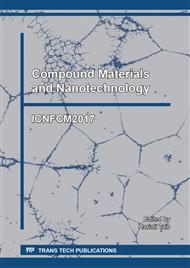p.3
p.8
p.15
p.20
p.26
p.33
p.39
p.47
Synthesis, Structural and Gas Sensing Characterization of W-Doped SnO2 Nanostructures
Abstract:
Tin oxide material has been extensively used for gas sensing application. Due to high operating temperature of metal oxide gas sensors, around 600 K and long term instability, research has been carried out to improve the material properties and reducing operating temperature. nanostructure materials have shown higher sensitivity and better stability towards gas environment. Air pollutants from automobiles and industry waste are the primary sources of environmental pollutants and there is need to develop low temperature, sensitive and selective gas sensors to monitor the gas content. In this paper, we have discussed the effect of Tungsten (W) doping in SnO2 nanostructures on the structural and gas sensing properties. The nanostructures have been synthesized by thermal evaporation process. The structural and surface morphology studies confirm the growth of nanowires on silicon substrates. The corresponding EDX spectra also confirm the doping of W into SnO2 nanowires. The gas sensor response of W-doped SnO2 nanowires was investigated upon exposure to various gases. It has been observed that doping of W enhances the NO2 sensitivity of nanowire based sensors at low temperature and the sensor response improves with increase in gas concentration.
Info:
Periodical:
Pages:
15-19
Citation:
Online since:
November 2017
Authors:
Price:
Сopyright:
© 2017 Trans Tech Publications Ltd. All Rights Reserved
Share:
Citation:


